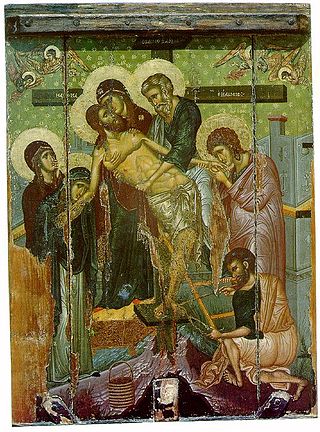Related Research Articles

Bodmin Moor is a granite moorland in north-eastern Cornwall, England, United Kingdom. It is 208 square kilometres (80 sq mi) in size, and dates from the Carboniferous period of geological history. It includes Brown Willy, the highest point in Cornwall, and Rough Tor, a slightly lower peak. Many of Cornwall's rivers have their sources here. It has been inhabited since at least the Neolithic era, when early farmers started clearing trees and farming the land. They left their megalithic monuments, hut circles and cairns, and the Bronze Age culture that followed left further cairns, and more stone circles and stone rows. By medieval and modern times, nearly all the forest was gone and livestock rearing predominated.

Joseph of Arimathea is a Biblical figure who assumed responsibility for the burial of Jesus after his crucifixion. Three of the four canonical Gospels identify him as a member of the Sanhedrin, while the Gospel of Matthew identifies him as a rich disciple of Jesus. The historical location of Arimathea is uncertain, although it has been identified with several towns. A number of stories about him developed during the Middle Ages.

Tristan, also known as Tristram, Tristyn or Tristain and similar names, is the folk hero of the legend of Tristan and Iseult. In the legend, his objective is escorting the Irish princess Iseult to wed Tristan's uncle, King Mark of Cornwall. Tristan and Iseult accidentally drink a love potion during the journey and fall in love, beginning an adulterous relationship that eventually leads to Tristan's banishment and death. The character's first recorded appearance is in retellings of British mythology from the 12th century by Thomas of Britain and Gottfried von Strassburg, and later in the Prose Tristan. He is featured in Arthurian legends, including the seminal text Le Morte d'Arthur, as a skilled knight and a friend of Lancelot. He is also a Knight of the Round Table.

The Scottsboro Boys were nine African American male teenagers accused of raping two white women in 1931. The landmark set of legal cases from this incident dealt with racism and the right to a fair trial. The cases included a lynch mob before the suspects had been indicted, all-white juries, rushed trials, and disruptive mobs. It is commonly cited as an example of a legal injustice in the United States legal system.

Petroc or Petrock was a British prince and Christian saint.

Demogoblin is a fictional character appearing in American comic books published by Marvel Comics.
Dozmary Pool is a small lake, in the civil parish of Altarnun on Bodmin Moor, Cornwall, UK. It is situated 16.9 kilometres (10.5 mi) from the sea and lies about 15 kilometres (9.3 mi) north-east of Bodmin and 2 kilometres (1.2 mi) south of Bolventor. It originated in the post-glacial period. The outflow from the pool is into Colliford Lake and is therefore one of the sources of the River Fowey. In the past the name has been spelt as Dozmaré and as Dosmery Pool. The pool and surrounding area was designated a Site of Special Scientific Interest in 1951 for its biological interest and is within the Cornwall Area of Outstanding Natural Beauty.

Roche is a civil parish and village in mid-Cornwall, England, United Kingdom. The village gets its name from the 20-metre (66-foot) high Roche Rock, a quartz-schorl outcrop east of the village. Roche is the Norman-French word for Rock. The parish population at the 2011 census including Belowda, Bilberry, Carbis, Coldvreath and Criggan is 3,381, and the ward population at the same census was 3,867.

Banchō Sarayashiki is a Japanese ghost story (kaidan) of broken trust and broken promises, leading to a dismal fate. Alternatively referred to as the sarayashiki tradition, all versions of the tale revolve around a servant, who dies unjustly and returns to haunt the living. Some versions take place in Harima Province or Banshū (播州), others in the Banchō (番町) area in Edo.

Germoe is a village and civil parish in Cornwall, England, United Kingdom. Germoe village, the parish's main settlement and church town, is about five miles (8 km) west of Helston and seven miles (11.3 km) east of Penzance. The A394 Penzance to Helston road runs along the southern border of the parish. Other settlements in the parish include Balwest, Boscreege and Tresowes Green.

The black dog is a supernatural, spectral, or demonic hellhound originating from English folklore, and also present in folklore throughout Europe and the Americas. It is usually unnaturally large with glowing red or yellow eyes, is often connected with the Devil, and is sometimes an omen of death. It is sometimes associated with electrical storms, and also with crossroads, barrows, places of execution and ancient pathways.

Elizabeth Lillian Woolcock was an Australian murderess who was hanged in Adelaide Gaol for the murder of her husband Thomas Woolcock by mercury poisoning. She remains the only woman ever executed in South Australia and is buried between the outer and inner prison walls of Adelaide Gaol. It has been argued that she may have been a victim of domestic violence and suffered from battered spouse syndrome.
Cruel Coppinger is a semi-legendary figure in Cornish folklore. Coppinger was a real person, but various legends grew up around him, lending him near superhuman powers and a fearsome reputation. He is portrayed as huge and fearsome Dane who after being shipwrecked off Cornwall became the leader of a feared band of smugglers.

Cornish mythology is the folk tradition and mythology of the Cornish people. It consists partly of folk traditions developed in Cornwall and partly of traditions developed by Britons elsewhere before the end of the first millennium, often shared with those of the Breton and Welsh peoples. Some of this contains remnants of the mythology of pre-Christian Britain.
Conomor, also known as Conomerus or Conomor the Cursed, was an early medieval ruler of Brittany. His name, which has the Welsh cognate Cynfawr, means "Great Dog", but could also indicate "Sea Dog" in early Brythonic. Conomor was notorious for his cruelty, becoming a legendary villain in Breton culture. He is widely regarded as one of the probable sources for the myth of Bluebeard and possibly also of Tristan's uncle King Mark of Cornwall. The wife-beating giant Cormoran may also retain a garbled folk memory of the same character.

The Ordinalia are three medieval mystery plays dating to the late fourteenth century, written primarily in Middle Cornish, with stage directions in Latin. The three plays are Origo Mundi, Passio Christi and Resurrexio Domini. The metres of these plays are various arrangements of seven- and four-syllabled lines. Ordinalia means "prompt" or "service book".

There are extensive and varied beliefs in ghosts in Mexican culture. In Mexico, the beliefs of the Maya, Nahua, Purépecha; and other indigenous groups in a supernatural world has survived and evolved, combined with the Catholic beliefs of the Spanish. The Day of the Dead incorporates pre-Columbian beliefs with Christian elements. Mexican literature and cinema include many stories of ghosts interacting with the living.

Pengersick Castle is a fortified manor house located between the villages of Germoe and Praa Sands, in the civil parish of Breage, in Cornwall, England. The tower house, which is in the parish of Breage, is a Grade I listed building. Parts of the building date from the early 16th century.

The Headless Horseman is an archetype of mythical figure that has appeared in folklore around Europe since the Middle Ages. The figures are traditionally depicted as riders upon horseback who are missing their heads. These myths have since inspired a number of stories and characters in popular culture, including "The Legend of Sleepy Hollow".

The Hammersmith Ghost murder case of 1804 set a legal precedent in the UK regarding self-defence: that someone could be held liable for their actions even if they were the consequence of a mistaken belief.
References
- ↑ "Cornish Saints and Sinners: The Tale of Jan Tregeagle". Britannia.com. Retrieved 30 July 2018.
- ↑ Classic Cornish Ghost Stories. 1994. p. 8. ISBN 978 085025 431 0.